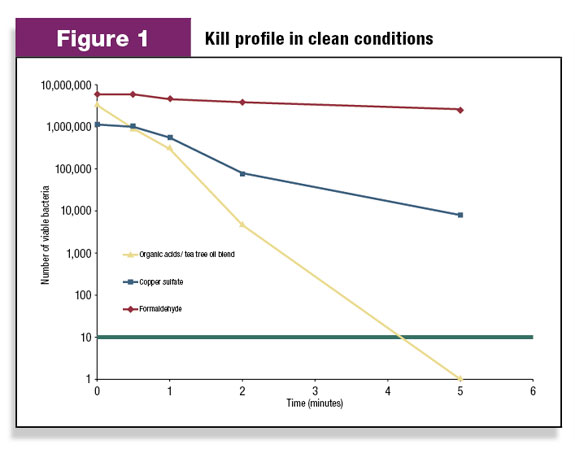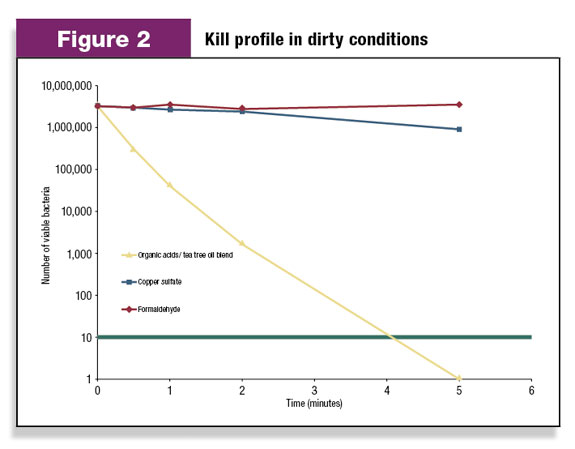Due to the global spread of digital dermatitis (hairy heel wart or strawberry heel) over the last 25 years, the prevention of lameness in dairy herds now ranks alongside fertility and mastitis as one of the top three farm management issues that have the most negative economic impact on a dairy. In the same time period, it has been widely accepted that once digital dermatitis is present on a given farm, it cannot be eradicated and so a regular footbathing regime must be implemented on-farm in order to control the background levels of causative organisms and to stop the spread of infection.
In addition to controlling the background levels of organisms, rapid and appropriate treatment measures must be taken when an outbreak occurs. A sudden rise in prevalence can be due to several factors, including introduction of first-calvers or seasonal weather changes.
There are many commercial products and chemicals which have been used for footbath solutions. A major difficulty in making an informed choice has been availability of a consistent and reproducible method for testing the performance of each under conditions that would mimic those experienced on the farm, where the footbath is often “dirty,” or in other words, contains significant levels of manure.
Professor Sean Gorman and myself based at the Queens University School of Pharmacy in Belfast, Northern Ireland, and our team have significant experience studying disinfection. Much of this experience has been gained in the area of surface disinfection, ranging from environmental (tables and floors) to medical devices (catheters and surgical equipment). We recognize that the use of a disinfectant in a heavily soiled environment (referred to as “dirty conditions”) represents a very different challenge from those experienced in light soiling (referred to as “clean conditions”).
When investigating dirty conditions such as is the case with footbaths, it is important to understand the influence of the solid matter present. It is known that most particles in aqueous solution carry a net surface charge. This charge can lead to the binding up of antibacterial agents, which can thus reduce their efficacy.
Manure is comprised of a wide range of biological content, including protein, lipid, cellular debris, cellulose, etc., which all have markedly different surface areas, surface charges and binding sites, leading to markedly different absorption capabilities.
Researchers were asked to test the efficacy of disinfection of several prominent footbath solutions under clean and dirty conditions.
In consideration of the test requirements, the research team previously mentioned selected an internationally recognized and standardized test method, BS EN 1276, which clearly sets out the procedures to be used for both clean and dirty conditions.
To mimic dirty footbath conditions, where particulate matter is present, the research team used bovine albumin (a common cow protein), which contains a high number of binding sites and is a material that is a consistent, reproducible challenge agent. This eliminates the variability that would be experienced if using farm manure or fecal matter as the in-solution particulate agent. The test solutions were tested at three times the concentration necessary to inhibit the visible growth of a microorganism.
Having selected the method for reproducing dirty footbath conditions, three test footbath solutions were examined, namely a copper sulfate solution, a formaldehyde solution and a proprietary product from Provita Eurotech, containing a blend of organic acids and tea tree oil. Each of the solutions were tested under clean conditions, dirty conditions and dirty conditions where the solid matter had been left standing in the test solution for 24 hours. The latter test was designed to mimic the on-farm situation where soiled footbaths are used for more than one milking.
The standardized test method BS EN 1276 defines an effective disinfectant as being one that kills more than 99.999 percent of the challenge organisms.

Under the clean test conditions, copper sulfate and formaldehyde did not meet the test criteria for a disinfectant, while the organic acid/tea tree oil solution met the test criteria in less than four minutes and by five minutes had achieved a total kill. ( See Figure 1. )
Under dirty conditions, at the five-minute time point the efficacy of copper sulfate and formaldehyde were reduced even further, while the efficacy of the first effective kill solution was maintained. ( See Figure 2. )

Among the solutions tested, the organic acid/tea tree oil solution demonstrated a consistent efficacy profile under all test conditions, including after standing for 24 hours in dirty conditions, while copper sulfate and formaldehyde failed to meet the test criteria.
This methodology has been shown to be repeatable and provides consistent data from which meaningful comparisons of footbath solutions under farm conditions can be made. PD
References omitted due to space but are available upon request by sending an email to editor@progressivedairy.com .
David S. Jones
Biomaterial Science Chair
Queens University Belfast
d.jones@qub.ac.uk





